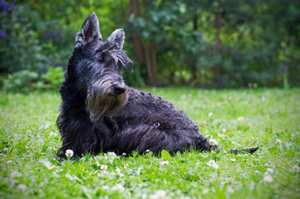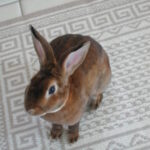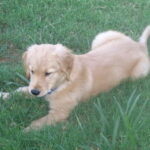Before you select a dog to bring into your home, it’s helpful to know a little about the particular breed history, temperament, and health problems typical for it’s type. In this article, we will discuss the top 10 small dog breeds for families and give an informative summary of each breed.
1. Dachshund
The Dachshund was originally bred for hunting, which is surprising when you consider their short legs and small bodies. However, their body type was perfect for burrowing in holes and running out rabbits, foxes and badgers. In fact, the name “dachshund” translates into the words “Badger Hound” in German.
The Dachshund is a loving, intelligent pet that enjoys patrolling outside areas and snuggling up to their owners at night. They are devoted animals that can become territorial, therefore making good watchdogs as their loud bark does not indicate their small size.
Health problems Dachshunds include slipped discs and invertible disc disease. To protect your pet, do not allow a Dachshund to jump up and down from furniture. Instead, provide a step stool to assist them with jumping.
The Yorkshire Terrier was first bred in England, although specifics of their breed history remain unclear. What is known, however, is that the breed has gradually diminished in size over the years, and the Yorkshire Terrier of today is a smaller animal than what was seen when they were first bred.
Loving, patient, and very intelligent, the Yorkshire Terrier is the perfect family pet. The fur on this magnificent animal can vary greatly in texture, color, and length, but they are commonly recognized as having longer hair.
Heath problems in Yorkshire Terriers include tooth decay, bronchitis, and bone fractures. The smallest of these dogs, known as “Teacup Yorkies” are at a considerably higher risk for these health problems as well as additional issues. To protect your pet, brush their teeth on a regular basis and regular exercise is essential to their well-being.
3. Chihuahuas
There is some debate over the origins of the Chihuahua. While some consider it to be indigenous to Mexico, others suspect that this breed hailed from China. Regardless, the Chihuahua is one of the most popular breeds of dogs and has been the subject of many children’s and family films.
The Chihuahua is unaffected by it’s small size and will attack dogs twice their size. Protective, loyal, and brave, the Chihuahua makes an excellent companion and is good family pet for families without very small children. Because of the Chihuahua’s small size, a young child may accidentally hurt or injure this animal in daily handling.
Health problems in Chihuahuas include gum disease, bone injury, glaucoma, colds, and stress and anxiety issues. Smaller Chihuahuas are at a higher risk for all of these health issues. To protect your pet, keep them away from cold weather and provide a healthy diet and regular exercise.
The word “pinscher” is German for terrier, although the Miniature Pinscher is not a terrier at all. Originally bred out of Germany in the 1800s, the Miniature Pinscher is in the “toy dog” family and it makes an excellent family pet.
Energetic, playful, and intelligent the Miniature Pinscher is typically black in color with tan markings. The ears set high off the head, giving it the appearance of always being “on guard”. Fearless and brave, this small dog breed makes an excellent watchdog and a loving pet.
Health problems in the Miniature Pinscher are virtually non-existent. This is a very healthy breed of dog that should not present any issues.
5. Pug
The Pug is believed to be one of the oldest breeds of dogs. It is suspected that the first Pug was bred before 400 BC. As with other dog breeds, there is some debate of where the Pug originated from. Some suspect they are Oriental descent, while others believe they were brought in from the Lowlands from Dutch Traders.
When you look at a Pug, you will either think it is the most adorable dog you have ever seen, or the ugliest. With it’s squished facial features, and pig-like tail, the Pug is a unique looking dog to say the least. No one will dispute the loving disposition of this breed. Attentive, watchful, and great with children, the Pug is an excellent small dog breed for families.
Heath problems in the Pug include breathing problems, frequent colds, allergies, and Encephalitis. While frequent grooming is not necessary with the Pug, regular veterinarian visits and exercise is essential.
6. Shih Tzu
The words “Shih Tzu” translates to “Lion Dog” in Chinese, which refers to the long flowing mane of hair found on untrimmed Shih Tzu dogs. This breed of dog was originated when Lhasa Apsos were cross bred with Pekingese.
The Shih Tzu is a happy, energetic dog that makes an excellent family pet. If kept ungroomed, the Shih Tzu’s hair can become easily knotted, so it is advised to keep them close shaved for easy care. Loving, intelligent, and friendly, the Shih Tzu is patient and good with children.
Health problems in the Shih Tzu include respiratory infections and slipped disc. To protect your pet, do not allow them to jump up and down from furniture.
7. Pomeranian
The Pomeranian was originally descended from the larger Keeshond dogs from the region of Pomerania. In the mid eighteenth century, Queen Victoria of Florence was presented with a Pomeranian dog, forever linking the breed to royalty.
The Pomeranian is an extremely loyal, very loving pet that will make an excellent addition to your family. Intelligent, quick to learn, and eager to please, this small dog breed can be easily trained to perform tricks and enjoys learning. Patient with children and always friendly, the Pomeranian is a highly sought after pet.
Health problems in Pomeranians include eye infections, skin conditions and tooth problems. To protect your pet, a diet of dry dog food is recommended. In addition, it is important to keep the eye area clean and free of debris.
8. Maltese
The Maltese is one of the oldest breeds of dogs, and originated from Italy, and was first recognized by the AKC in the year 1888. They are most recognized by their silky fur that is all-white in color.
The pristine appearance of the Maltese is deceptive, as they make excellent watchdogs and are as protective as they are loving. This small dog breed is loyal, energetic, intelligent, and fun to be around. Patient with children and a devoted companion, this is an excellent small dog breed for families.
Health problems in Maltese include respiratory issues. In addition, their long fur requires a great deal of attention and care.
9. Miniature Poodle
The Miniature Poodle was bred down from the standard Poodle, to create a small pet that is good for families. Typically, to fit in the class of “miniature” this breed of Poodle will not exceed 15″ in height.
Many Miniature Poodle dogs are used for acrobatic performers, thus they are smart, eager to learn, and quick to catch on to new tricks. Good natured, friendly, and happy animals, the Miniature Poodle makes an extremely loyal pet and is extremely patient with children.
Health problems with Miniature Poodles include hip dysplasia and eye and ear problems. To protect your pet, regularly clean their ears and eyes to prevent infection.
10. Scottish Terrier
The Scottish Terrier was originally bred to control rodents and vermin in the Scottish Highlands, but are now used as show dogs or as family pets. They are inbred with the instinct to hunt, and are naturally curious creatures.
Of all the dogs on this list of small dog breeds for families, the Scottish Terrier is the most independent. While they will make a loving pet, they tend to stay to themselves and are typically a quiet breed of dog. Intelligent and calm, but friendly and outgoing, the Scottish Terrier is easy to care for and fine when left on their own.
Health problems with the Scottish Terrier include very little, but deafness is a risk to be aware of.
Sources:
Personal knowledge & experience
www.gopetsamerica.com
www.dogbreedinfo.com





